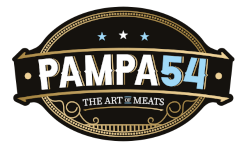Our Products / PAMPA54
Our Beef
of Argentine Angus Meat
Superior Quality and Flavor
Grass-Fed: Many Argentine cattle are grass-fed, contributing to a more natural, robust flavor profile. Grass-fed beef also tends to have a higher concentration of beneficial omega-3 fatty acids.
Nutritional Value
Vitamins and Minerals: It is rich in essential nutrients, including iron, zinc, and B vitamins, which support various bodily functions such as immune health and energy metabolism.
Sustainable and Ethical Farming Practices
Lower Carbon Footprint: Pasture-raised cattle contribute to soil health and biodiversity, reducing the overall carbon footprint of beef production.
Global Recognition and Heritage
Cultural Heritage: Beef is an integral part of Argentine culture and cuisine. The traditional asado (barbecue) showcases the country's premium meat cuts, celebrating the rich culinary heritage of Argentina.
Versatility in Cooking
Consistent Quality: The high standards of breeding and raising Angus cattle in Argentina ensure consistent quality across different cuts, making it a reliable choice for various culinary applications.
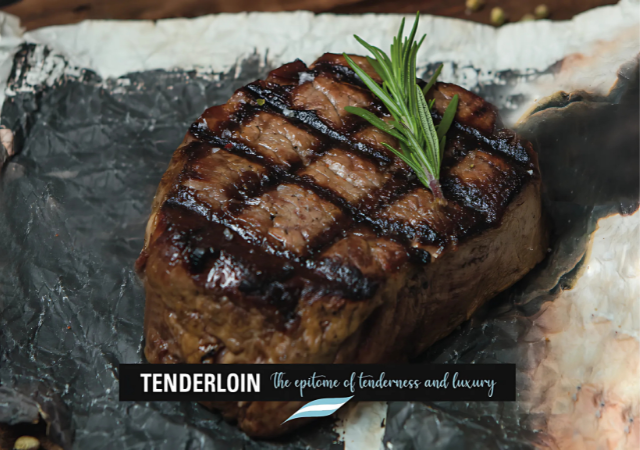
TENDERLOIN
The epitome of tenderness and luxury
Technical
The tenderloin is a lean and tender cut of beef that comes from the loin area of the cow. It is located near the spine and does minimal work, making it exceptionally tender.
Taste It
It is prized for its buttery texture and mild flavor. It is often considered one of the most tender cuts of beef and is highly sought after for its tenderness and juiciness.
Cooking
It is best suited for quick cooking methods such as grilling, roasting, or pan-searing. It should be cooked to medium-rare or medium to preserve its tenderness and juiciness.
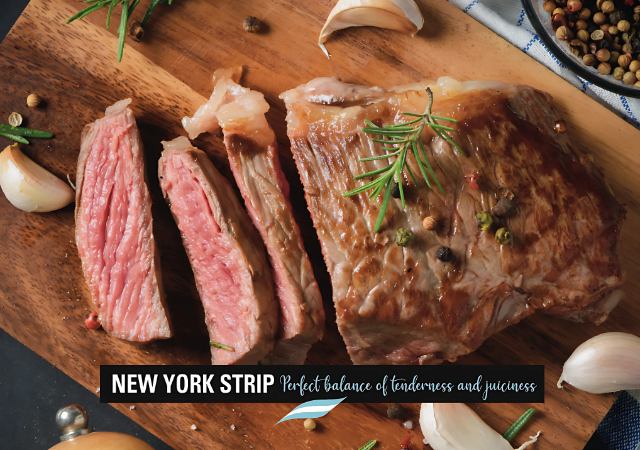
NEW YORK STRIP
Perfect balance of tenderness and juiciness
Technical
The New York strip, also known as the strip steak, comes from the short loin of the cow. It is a cut with a strip of fat along one edge, which enhances flavor and juiciness.
Taste It
It is known for its bold beefy flavor and the right amount of fat, which contributes to its juiciness and tenderness. It has a slightly firmer texture compared to tenderloin but is still very tender when cooked properly.
Cooking
It is versatile and can be cooked using various methods such as grilling, broiling, or pan-searing. It is best cooked to medium-rare or medium to fully develop its flavor and maintain its tenderness.
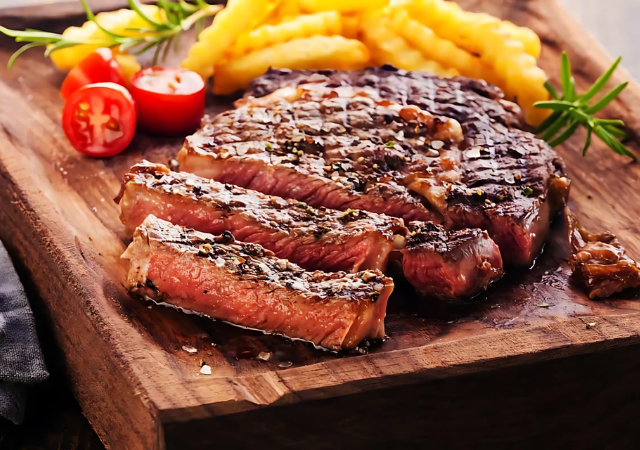
RIBEYE
Is a top choice for steak lovers
Technical
The ribeye, also known as the rib steak or ribeye steak, is cut from the rib section of the cow. It is well-marbled with fat, which gives it exceptional flavor and juiciness.
Taste It
It is prized for its rich, beefy flavor and high level of marbling, which makes it incredibly tender and juicy. It has a luxurious mouthfeel and is often considered one of the most flavorful cuts of beef.
Cooking
It is best cooked using high-heat methods such as grilling or pan-searing to develop a delicious crust while keeping the interior juicy and tender. It is best cooked to medium-rare or medium for optimal flavor and texture.
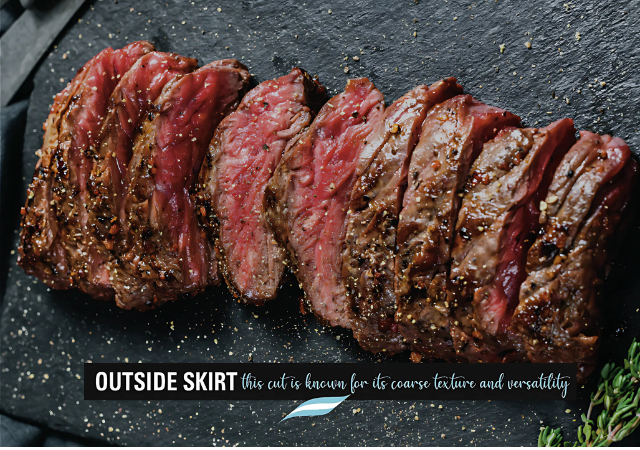
OUTSIDE SKIRT
This cut is known for its coarse texture and versatility
Technical
The outside skirt steak comes from the diaphragm muscle of the cow, located between the ribs and the abdomen. It is a thin, flavorful cut with long muscle fibers.
Taste It
It is known for its intense beefy flavor and coarse texture. It has a robust flavor profile and is slightly chewier compared to other cuts, but when cooked properly, it can be incredibly tender and flavorful.
Cooking
It is best suited for high-heat cooking methods such as grilling or broiling. It should be cooked quickly over high heat to sear the exterior and lock in juices. It is best served medium-rare to medium for optimal tenderness and flavor.

TRI TIP
Making any meal a gourmet experience
Technical
The Tri Tip is a triangular cut of beef from the bottom sirloin subprimal. It is relatively lean and is named for its triangular shape.
Taste It
It is known for its rich, beefy flavor and tender texture when cooked properly. It has good marbling, which adds to its juiciness.
Cooking
Best suited for grilling, roasting, or smoking. It should be cooked to medium-rare or medium and sliced against the grain for optimal tenderness.
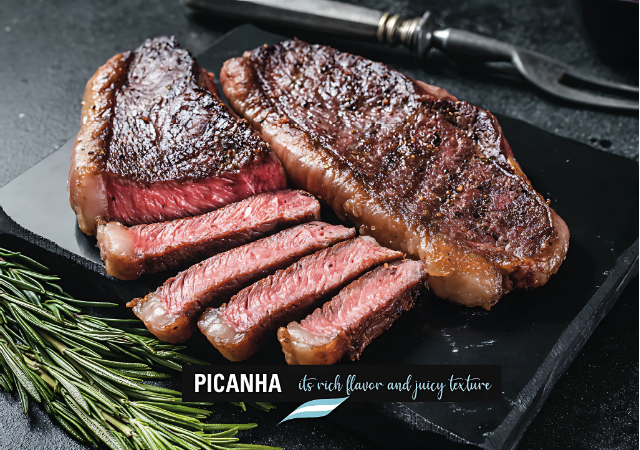
PICANHA
Its rich flavor and juicy texture
Technical
The Cap of Rump, also known as the Coulotte or Picanha, is a cut from the top of the rump. It includes a thick layer of fat, which adds to its flavor and juiciness.
Taste It
This cut is highly prized for its rich, beefy flavor and juicy texture, with the fat cap providing extra tenderness and taste.
Cooking
Best cooked by grilling or roasting (Brazilian style). It is typically seared to render the fat and then cooked to medium-rare to medium. Slice against the grain for maximum tenderness.
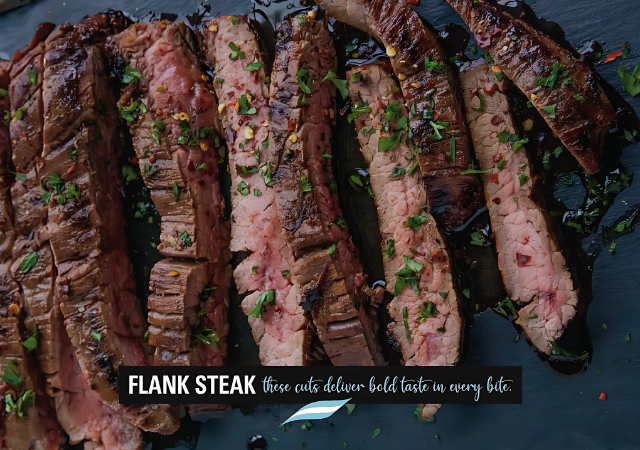
FLANK STEAK
These cuts deliver bold taste in every bite.
Technical
The flank steak is sourced from the abdominal muscles or lower chest of the cow, specifically from the section between the rib and the hip.
Taste It
Flank steak is known for its robust, beefy flavor. Due to its low fat content, it offers a concentrated taste, making it a favorite for those who appreciate a strong, meaty profile.
Cooking
Ideal for marinating and grilling or searing quickly over high heat. Best served medium-rare to medium and sliced thin against the grain.
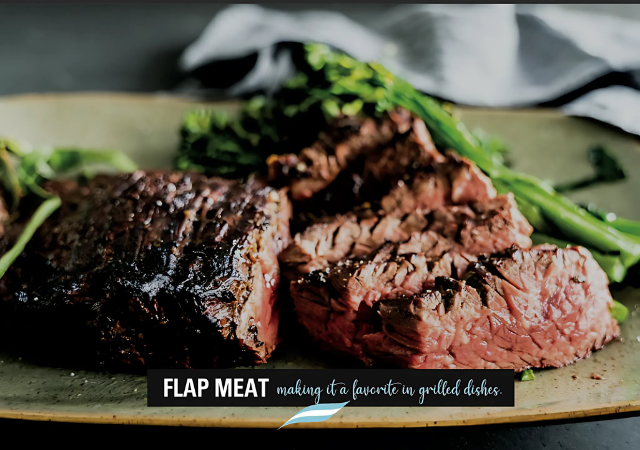
FLAP MEAT
Making it a favorite in grilled dishes.
Technical
Flap meat is sourced from the bottom sirloin, just below the rib cage and above the flank. It is part of the oblique muscles, specifically from the diaphragm area.
Taste It
Flap meat is celebrated for its deep, beefy flavor, which is more pronounced than many other cuts. The fat marbling throughout the meat contributes to its juiciness and rich taste, making each bite flavorful and satisfying.
Cooking
Flap meat benefits from a simple marinade or dry rub to enhance its natural flavors. Common marinades include citrus, garlic, and herbs, which not only flavor the meat but also help to tenderize it.
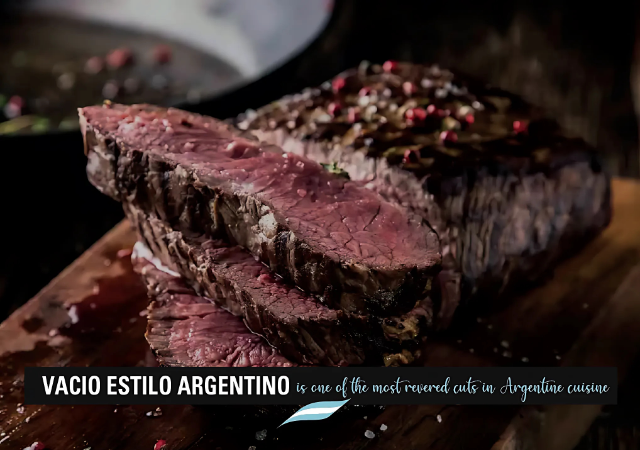
VACIO ESTILO ARGENTINO
Is one of the most revered cuts in Argentine cuisine
Technical
It comes from the flank section of the cow, specifically the lower abdominal muscles, but it’s a larger, thicker cut than what is commonly known as flank steak. It includes part of the diaphragm muscle and is positioned between the ribs and the hip.
Taste It
It is celebrated for its intense, beefy flavor, which is richer and more complex than many other cuts. The combination of lean muscle and the fat cap results in a juicy, flavorful bite with every slice.
Cooking
It is typically seasoned simply with coarse salt to allow the natural flavors of the beef to shine. In some cases, a basic marinade of garlic, herbs, and olive oil is used, but the emphasis remains on the meat's inherent taste.
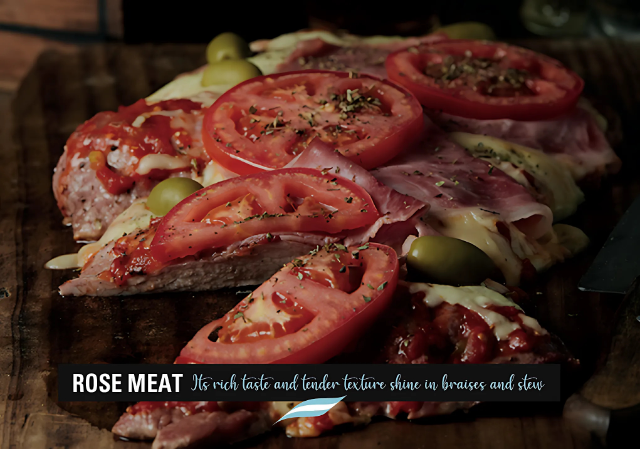
ROSE MEAT
Its rich taste and tender texture shine in braises and stew
Technical
Rose Meat comes from the underside of the cow, specifically from the layer between the skin and the ribs, running along the sides of the rib cage. It is a long, flat piece of meat, distinct for its thinness and wide shape.
Taste It
It offers a delicate, mild beef flavor that is less intense than thicker cuts. Its thinness allows it to absorb flavors from marinades or fillings well, making it a versatile cut that can take on a variety of taste profiles.
Cooking
Rose Meat can be marinated in a variety of ingredients, including garlic, herbs, vinegar, and citrus, to enhance its flavor and tenderness. It can also be stuffed with vegetables, eggs, and other fillings before being rolled and tied for cooking.
